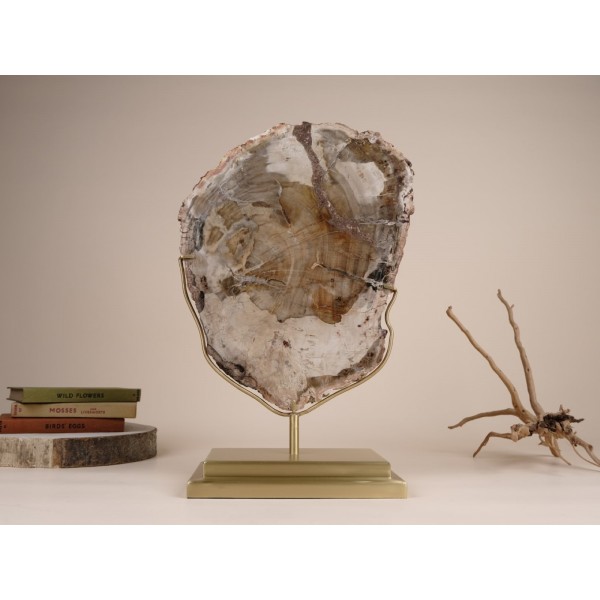Douveilliceras mammilatum - Ammonite
A huge, beautiful coloured Douveilliceras mammilatum from the Albian period, Upper Cretaceous (110 million years) of Mahajanga Province - Madagascar.
A perfect piece for decor, mounted in a handmade wood base.
| close |
This shop uses cookies to improve your experience on our website. |
Reference: N379
A slice of petrified tree, mounted on a handmade brass support.
It comes from the Tsingy de Bemaraha National Park in Madagascar.
Great pattern and colours. A one of a kind piece.
Dimensions: 38 cm x 24 cm // Stand: 20 cm x 12,5 cm 3,5 cm
Weight: 2,8 Kg

A slice of petrified tree, mounted on a handmade brass support.
It comes from the Tsingy de Bemaraha National Park in Madagascar.
Great pattern and colours. A one of a kind piece.
A huge, beautiful coloured Douveilliceras mammilatum from the Albian period, Upper Cretaceous (110 million years) of Mahajanga Province - Madagascar.
A perfect piece for decor, mounted in a handmade wood base.
Hand-Polished Petrified Wood Bowl crafted by local artisans. This unique bowl showcases petrified wood from the Araucaria species, dating back 220 million years to the Early Triassic period. Meticulously polished by hand, the bowl features stunning patterns and colors inherent to the petrified wood.
Sourced from the Tsingy de Bemaraha National Park in Madagascar.
This beautiful ammonite is a Jurassic Cleoniceras from Madagascar that preserves part of the original mother-of-pearl iridescent shell.
The Ammonite doesn't have any gluing work, the fracture lines on the shell are internal and do not affect the integrity of the fossil.
Phacops sp. from the Middle Devonian period ( 395 million years ) of the Djebel Issoumour area, Atlas Mountains - Morocco.
Prepared and restored, excellent for beginner collectors or as decor piece, in an acrylic base.
Madagascar Copal Amber with leaves and insects in a handmade brass base.
Amber is a substance derived from resins (Fossil Resin) of trees and plants that, buried for millions of years, underwent into a fossilization process.
These resins produced by plants acted as protection against the action of bacteria and against the attack of insects that punctured the bark until reaching the interior of the trees.
Over millions of years, amber-forming organic substances ended up forming a hardened, weather-resistant resin.
An exceptional Museum Quality slab with five Gigantopecten restitutensis fossil from Vaucluse quarry in S.E. France.
Lower Miocene (Burdigalien), around 20 to 16 million years.
It is very well prepared and clean, a "one of a kind" piece!
Outstanding slab with three Gigantopecten restitutensis fossil from Vaucluse quarry in S.E. France.
Lower Miocene (Burdigalien) around 20 to 16 million years.
Very well prepared and clean.
Perisphinctes sp. Ammonite from late Jurassic Period (160 million years), mounted in a exotic Tacula wood base.
Beautiful natural composition, from Sakahara fields in Southwestern Madagascar.
Phacops sp. from the Middle Devonian period ( 395 million years ) of the Djebel Issoumour area, Atlas Mountains - Morocco.
Prepared and restored, excellent for beginner collectors or as decor piece, in a black lacquered wood pedestal.
Metacanthina barrandei from the Middle Devonian period (395 million years) of the Djebel Issoumour area, Atlas Mountains - Morocco.
Mounted in a black lacquered wood base.
Natural, unbroken slab filled with wonderful naturally occurring orthoceras fossils that was once part of the prehistoric ocean floor over 400 million years ago, in a rose marble base.
As these forms of prehistoric squid were covered in ocean sediments prior to fossilization, the majority of the creatures will be facing in the same relative position, having been lined up by currents on the sea floor prior to being buried.
The fossils are exposed in their natural surrounding matrix. The slab features normal relief as well as dramatic natural texture and detail they had tentacles and ink sacs, much like present-day squid.
Except for belemnites, cephalopods had external shells with hollow internal chambers separated by walls called septa. Devonian period, ca. 410 million years, Anti-Atlas Mountains - Southern Morocco.
Carcharocles megalodon - Neogen - Miocene, Burdigalian (15.97 - 20.44 million years) - Indonesia. A huge, extra large and superb tooth, with a wonderful colouration, as characterise the megalodon of Indonesia. Beautiful teeth with a colour very similar to those of Chile and Peru, deposits closed for a long time. These megalodons have been on the market very recently.
Perisphinctes virguloides ( Ammonite ) Pair in acrylic base. A beautiful pair of this elusive fossil specimen from the Madagascar Upper Jurassic ( +/- 180 million years ) still very good structure details.
A good collection starter.
A superb Scyphocrinites elegans in a handmade brass display.
A One of a Kind piece, from Permian period (358 to 419 million years) of Erfoud - Morocco, an extinct genus of crinoid Camarocrinus.
Vasum Locklini - a Turbinellidae from the Caenozoic period (around 3 million years) from Florida - USA.
Always a beautiful intricate shell, mounted in a black lacquered wood base.
Aioloceras besairiei Lower Cretaceous, Albian period (100,5 – 113,0 million years ) from Mahajanga, Madagascar, in a black lacquered wood base.
Beautiful twin Aioloceras ammonite with most of the original nacreous shell layers (mother of pearl) preserved. Both sides have been prepared.